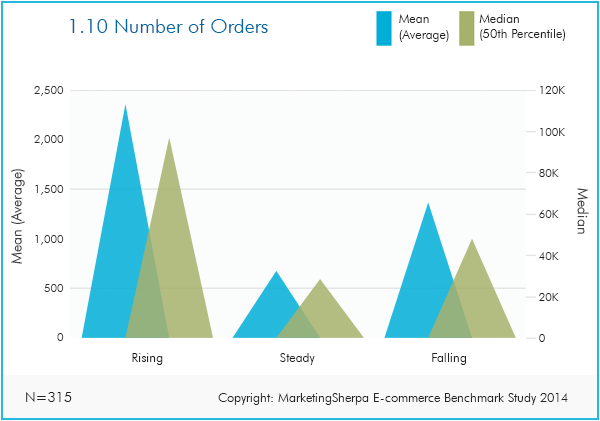by
Daniel Burstein, Director of Editorial Content
In the
MarketingSherpa Ecommerce Benchmark Study survey, we asked:
Q. Please indicate the 2013 level of the following metrics and their ongoing trend. One of the metrics we asked about was number of orders during 2013, asking both for the specific number as well as if that number was rising, steady or falling.
The chart below shows the resulting responses, segmented by how the companies' orders were trending. The average number of orders is in blue (with the corresponding number on the y-axis to the left of the chart), and the median responses are in green (corresponding to the numbers in the y-axis on the right of the chart).

Click here to see a printable version of this chart
I'll give a deeper explanation of the data above before bringing up a few points of analysis to help you make use of these findings in your daily ecommerce efforts.
Companies with more orders were more likely to have a rising number of orders, while companies with the least amount of orders were more likely to have their number of orders hold steady.
For example, "rising" companies had an average of 113,462 orders in the past year, while "steady" companies had an average of 34,733 orders, and "falling" companies averaged 64,584 orders.
Likewise, the medians were 2,000 orders for rising, 550 for steady and 1,000 for falling. These differences between median and mean indicate there were outliers on the very high end that pulled the averages up across all of the groups.
More companies are getting a rising number of orders
There were 212 companies with a rising number of orders, 73 companies with a steady number of orders, and 30 with a falling number of orders.
While companies with more orders were more likely to have a rising number of orders, it should be noted that the proportions between the mean and median were the same throughout the groups. This indicated that there is likely not much of a difference in order trend and number of orders, since all groups faced the same distribution — a grouping of orders around a median with a few very large outliers pulling up the average.
Increasing the number of orders for your company
In the Benchmark Study survey, one marketer responded by saying, "My customer base has an unusually high number of repeat orders, but I'm guessing it's just the nature of the industry. My average customer orders three times per year. I have some customers who order every month."
This brings up the point that the actual number of orders you see in the above chart will likely vary by industry, product type and the like. While a shoe seller might, for example, have a more high-volume business and need several orders per customer to make investments in customer acquisition worthwhile, a retailer selling a high-ticket item, like televisions, likely does not need as many orders in as short a period of time.
Please note, the overall number of orders is not the main lesson in the above chart. The main lesson is that most ecommerce companies are experiencing a rising numbers of orders, and if you aren't, that is a threat to your overall success.
One way to address this threat is to get more juice from the squeeze, so to speak.
If you are challenged by the number of orders your company is receiving, you could try to get higher margins from your orders or you can copy the approach of one of the marketers who participated in the survey. His challenge was "increasing multiple product orders," and he solved it when he "offered packaged deals."
Still, a successful, sustainable company relies on more than just getting larger orders. Rather, winning true customers, not just occasional buyers, should be a constant goal for companies. As one marketer replied, "We are quite successful in getting the customer targets. The challenge was in retaining the customer for repeat orders."
The solution to this is to better serve your buyers and win them over to the point where they become true customers.
As I mentioned in the beginning of this article, through an analysis of the
Ecommerce Benchmark Study, our team identified four factors that best differentiated survey respondents' success scores:
- Order trends
- Value of products and services compared to competitors
- Gross margin level
- Product and service guarantees compared to competitors
As you can see, "Value of products and service compared to competitors" and "Product and service guarantees compared to competitors" were two of those factors, indicating that the truly successful ecommerce companies are the ones that are able to meet or exceed buyer expectations on that first purchase. This generates the possibility of winning a true customer, who will then repeatedly order from their online store.
Related Resources
MarketingSherpa Ecommerce Benchmark Study — Made possible by a research grant from Magento, an eBay company
Ecommerce Research Chart: Returning visitorsEcommerce Research Chart: Does customer responsiveness correlate with success?Customer-centric Marketing: How transparency translates into trust [More from the blogs]
Social Media Marketing: Focus on consumer reviews increases Facebook fans 100% for Playtex BabyB2B Retargeting: How Lumension achieved an 865% lift in homepage views










